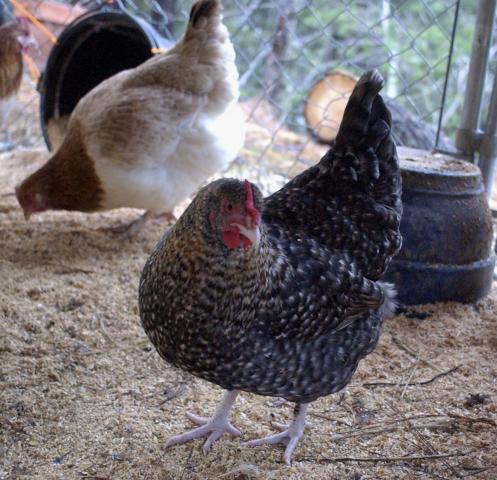Quote:
Well if they are mixed blue or splash cuckoo, with single barring gene, you will get some unbarred hens that show the true background color under the barring. I suspect they are mixed with wheaten, which doesn't "darken up" as easily as pure Birchen or Extended Black based cuckoo or blue cuckoo. If the chicks started out white then they are probably silver wheaten based hybrids. If you hatch enough, the at some point the genes will match back up and you will get the pure wheaten, some of them with cuckoo pattern, some without. You could end up with some interesting combinations but the chances of a really good one are slim, unless you hatch a ton of chicks. Kind of like winning the lottery. You could get a silver blue wheaten or something cool like that. I'm curious if you get that patchy blue pattern without the barring.
Wheaten probably came from any golden cuckoo blood that's in the mix. You definitely have splash or blue in there too, and they look like they are silver.
VC the chicks hatch out either blue or very light cuckoo looking, this hatch I have one that is black and white looks like any other breeds mottled chick keeping a close eye on that one. I really don't remember what the first mottled ones looked like in their down but I think they had blk on white markings.
Most mottled breeds don't have black and white chicks. Mottled breeds like Ancona, Speckled Sussex, Jubilee Orpington, Mille Fleur Cochin etc. don't show the mottling in the chickdown. Are you thinking like Exchequer Leghorn type coloring? Those have black and white chickdown, but black spots on white chickdown is usually one dose of the Dominant White gene with the original color leaking through. The mottling gene is recessive, and produces a very specific marking at the tip of each feather. With true mottleds you don't have patches of white and patches of dark. Black mottle chickdown is predominantly black with the white belly and face extended a bit more than the typical "penguin" look of black chicks. You can find pictures of black mottled d'uccles and pekins online.
Well if they are mixed blue or splash cuckoo, with single barring gene, you will get some unbarred hens that show the true background color under the barring. I suspect they are mixed with wheaten, which doesn't "darken up" as easily as pure Birchen or Extended Black based cuckoo or blue cuckoo. If the chicks started out white then they are probably silver wheaten based hybrids. If you hatch enough, the at some point the genes will match back up and you will get the pure wheaten, some of them with cuckoo pattern, some without. You could end up with some interesting combinations but the chances of a really good one are slim, unless you hatch a ton of chicks. Kind of like winning the lottery. You could get a silver blue wheaten or something cool like that. I'm curious if you get that patchy blue pattern without the barring.
Wheaten probably came from any golden cuckoo blood that's in the mix. You definitely have splash or blue in there too, and they look like they are silver.
VC the chicks hatch out either blue or very light cuckoo looking, this hatch I have one that is black and white looks like any other breeds mottled chick keeping a close eye on that one. I really don't remember what the first mottled ones looked like in their down but I think they had blk on white markings.
Most mottled breeds don't have black and white chicks. Mottled breeds like Ancona, Speckled Sussex, Jubilee Orpington, Mille Fleur Cochin etc. don't show the mottling in the chickdown. Are you thinking like Exchequer Leghorn type coloring? Those have black and white chickdown, but black spots on white chickdown is usually one dose of the Dominant White gene with the original color leaking through. The mottling gene is recessive, and produces a very specific marking at the tip of each feather. With true mottleds you don't have patches of white and patches of dark. Black mottle chickdown is predominantly black with the white belly and face extended a bit more than the typical "penguin" look of black chicks. You can find pictures of black mottled d'uccles and pekins online.
Last edited:







